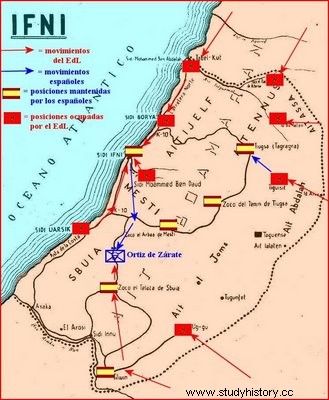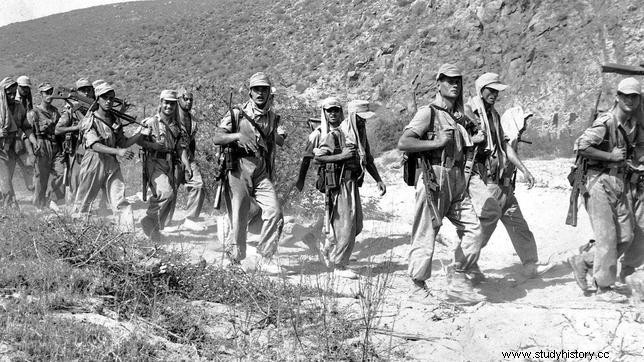A short time ago we published an entry dedicated to the colonial conflicts of Spain in Moroccan territory, specifically the so-called Annual disaster. We continue this analysis with another conflict of the same type but more recent:we refer to the Sidi Ifni war (November 1975-February 1958).
Sidi Ifni was a territorial enclave that was part of the Spanish protectorate in Morocco and that Spain effectively occupied between 1934 and 1969 (map 1). Shortly after Moroccan independence from France and Spain (1956), the North African troops increased the pressure on the territorial enclave of Ifni (map 2), starting a brief war but which had to be concluded by a joint military intervention by Spain and France. . Both countries mobilized some 14,000 soldiers and 140 planes, and managed to defeat the Moroccan troops. The conflict ended with the cession of the area of Tarfaya -or Cabo Juby- to the newborn kingdom of Morocco, while the rest of the territory remained in Spanish hands until 1969.
 Map 1. Spanish Protectorate in Morocco. Source:http://cybergeo.revues.org/23461
Map 1. Spanish Protectorate in Morocco. Source:http://cybergeo.revues.org/23461  Map 2. Military campaigns in Ifni. Source:http://www.sidi-ifni.com/
Map 2. Military campaigns in Ifni. Source:http://www.sidi-ifni.com/ The Spanish troops that participated in the conflict were mainly the Legion and parachute forces, but replacement troops were also sent, poorly trained and prepared to fight in a strange land and for reasons they did not understand. It was, at the time, an anachronistic armed confrontation, an example of the colonial conflicts that were causing an unstoppable decolonization process.

Although this conflict is an example of a forgotten war, it is part of our most immediate history and the memory of generations that are still alive. In the same way, and like any military confrontation, it caused victims:some 300 Spaniards died and another 500 were wounded, while it is estimated that among the Moroccan troops it caused some 8,000 victims.
Webgraphy
- http://elpais.com/elpais/2012/06/29/opinion/1340969043_360451.html.
- http://www.elmundo.es/elmundo/2011/02/19/espana/1298112287.html
- http://www.abc.es/historia-militar/20130118/abci-ifni-guerra-espana-libro-201301171321.html
